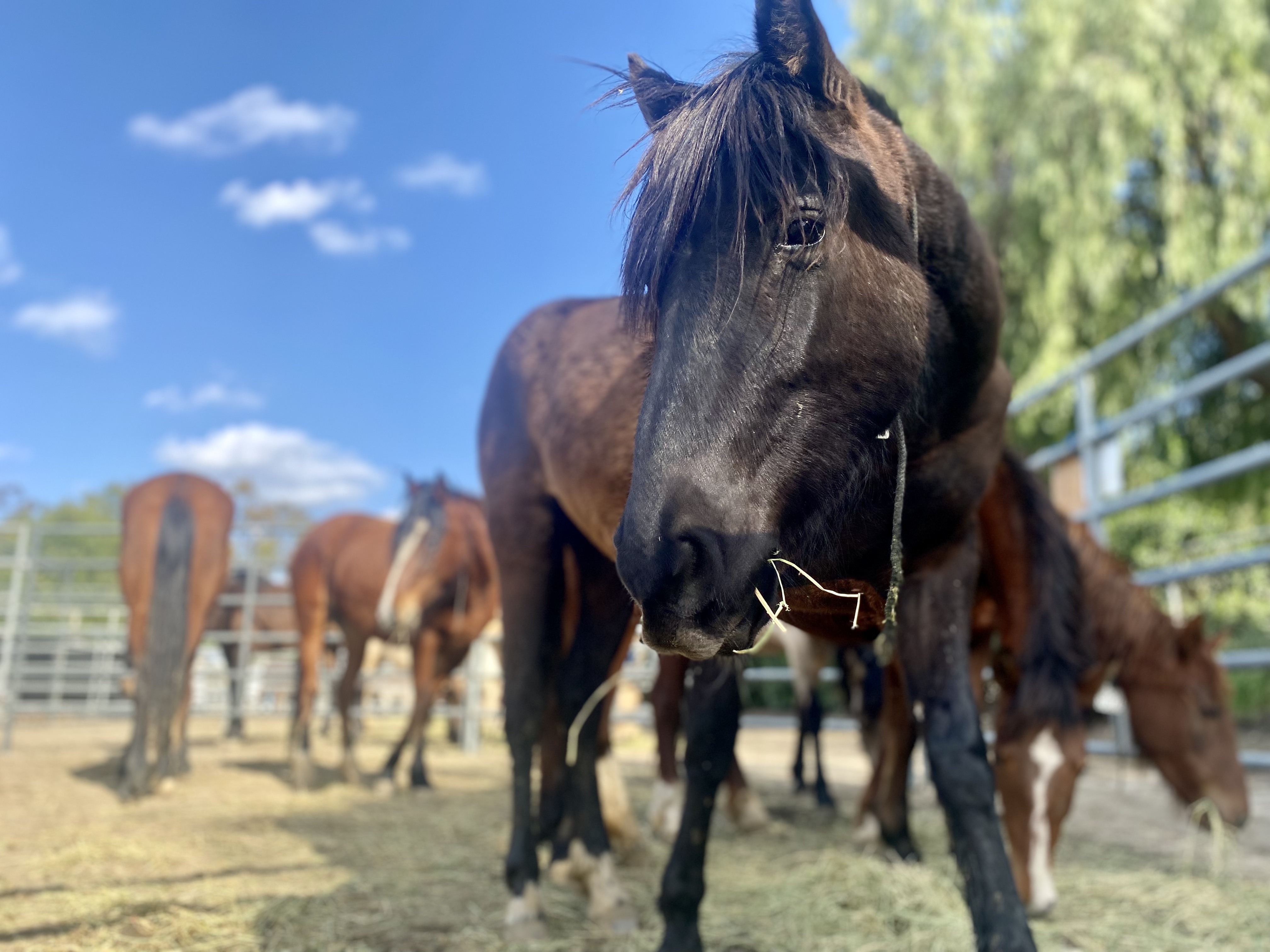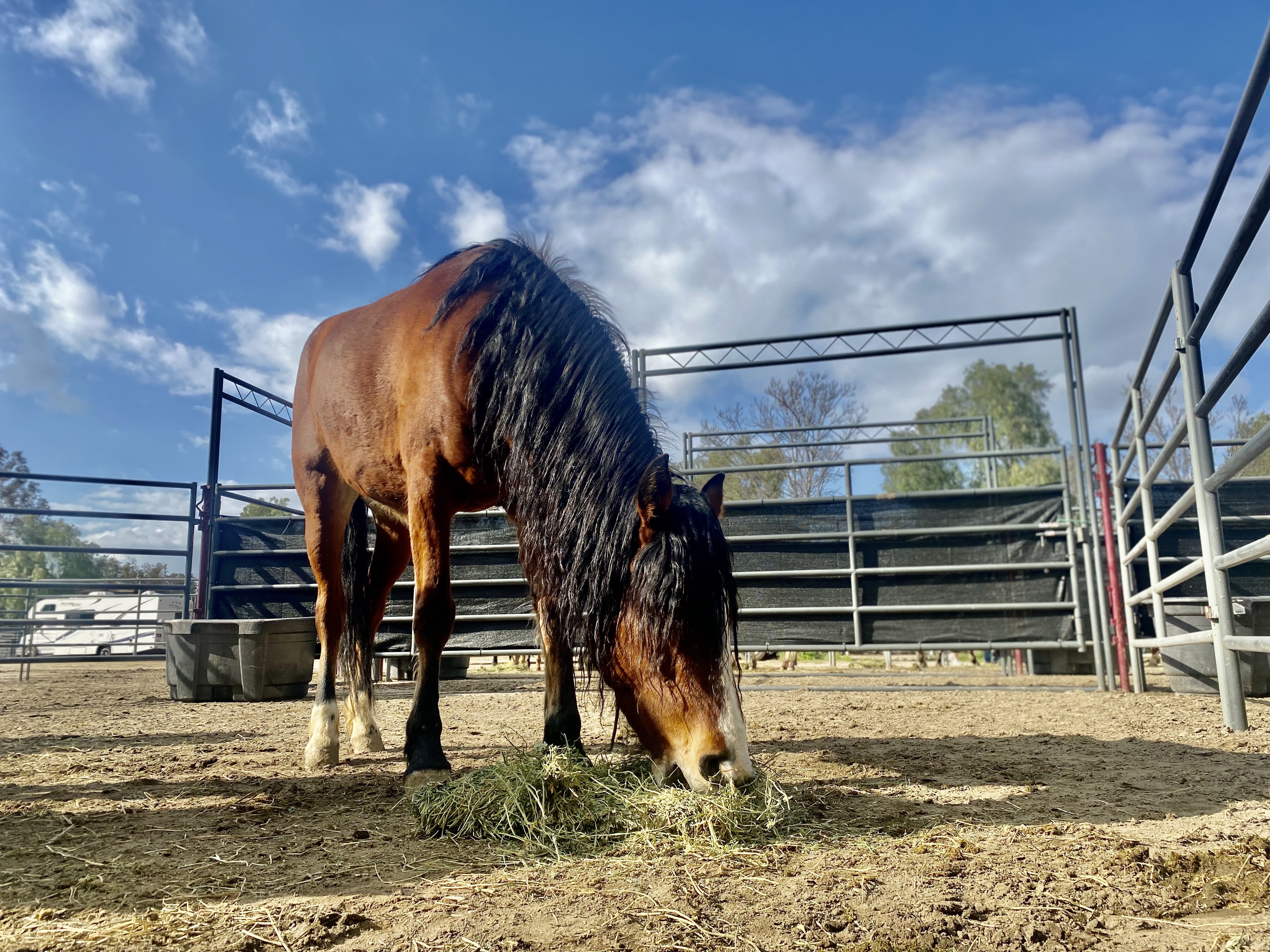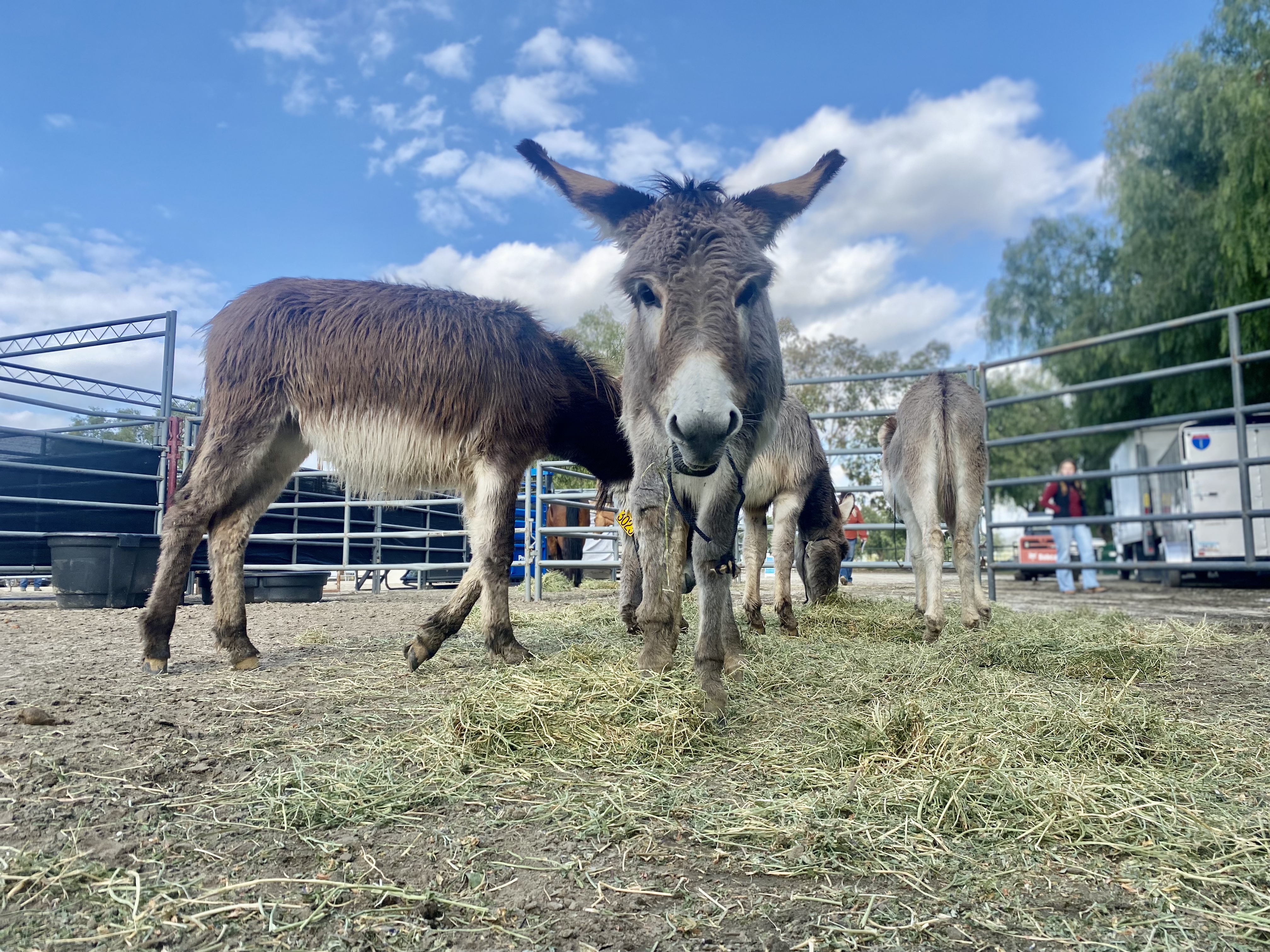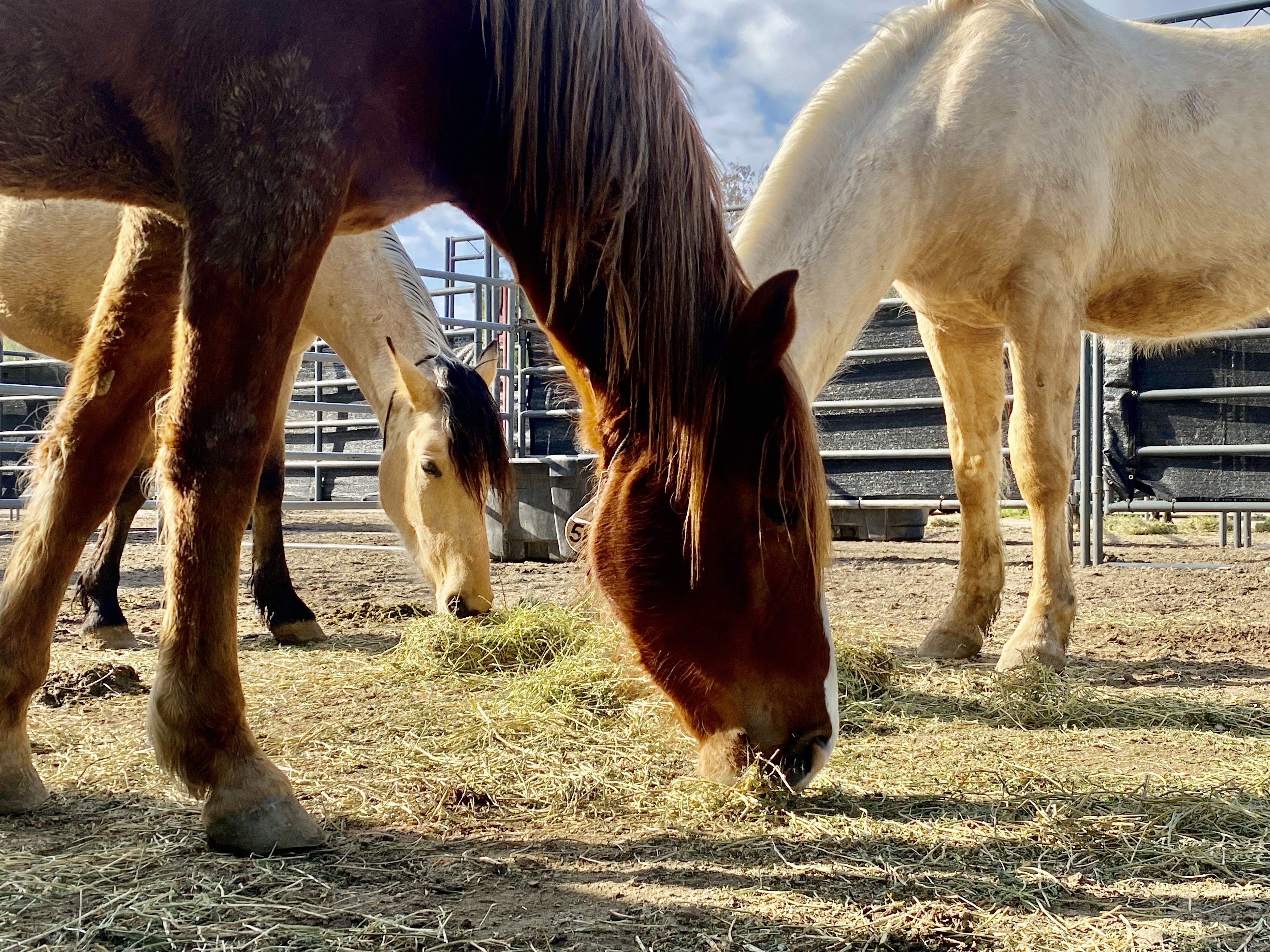Federal tax dollars fund the horse slaughter pipeline
Critics say a program intended to relieve taxpayers pays off ‘kill buyers’
By Rachel Hallett
A lone helicopter chops through the sky over the Del Mar Fairgrounds stables in San Diego, California. Trigger peers up, as the helicopter slowly crosses overhead. He watches until the horizon is clear. He huffs at his blonde mane, brushing his wispy bangs out of the way and stamps his hooves.
“We’re just guessing he was gathered more than once. And he knows, it’s been many years and he’ll hear something and he’ll look at the helicopters coming over,” says Susan Kerr. Her husband is Bobby Kerr, wild mustang trainer and rodeo performer.
“He doesn’t get scared or anything, he’s just always looking. Looking at the sky.”
As Susan brushes Trigger’s mane, Bobby emerges from their trailer, tipping his cowboy hat as he steps out. Trigger snorts, bearing his stained porcelain teeth into a goofy grin. It’s almost show time.
“In the mustang deal, you’ve got what you’ve got,” says Bobby, “And I’m glad I got him.”
Bobby purchased Trigger through the Bureau of Land Management for only $125 from one of their Northern California Herd Management Areas. He was gathered by helicopter, a method of wild horse management used by BLM for decades. From the sky, BLM chases horses for miles, separating them from their herd to round them up in their holding facilities.
For BLM, this is their method of wild horse population control. For animal advocates, this is animal cruelty. And for taxpayers, this is expensive.
BLM says wild horse management is necessary to protect the local area’s finite resources and natural wildlife. Without intervention, they say that their extensive overpopulation causes them to die by either starvation or dehydration.
Once the wild horses are captured, they are ushered into BLM’s holding facilities. But the more horses in their holding facilities, the higher the bill.
“Anytime you mix animals and money, the animals always lose.”
— Amelia Perrin
As of 2022, BLM, a federally funded organization, manages some 85,000 wild horses on public lands . BLM says that number is three times as many as the land can sustainably support in conjunction with other legally mandated uses. It costs federal taxpayers $78 million a year to fund BLM’s wild horse facilities and management programs.
To relieve some costs, BLM established the Adoption Incentive Program in 2019, which pays adopters $1,000 to take a wild horse home. The goal: incentivize buyers after years of dwindling adoption rates, and crowding numbers in their holding facilities. By placing more wild horses in “good homes,” BLM gets the horses out of their facilities, ultimately saving taxpayer dollars and managing western ecosystems.
But for animal activists, the Adoption Incentive Program rang alarm bells. Congress outlawed horse slaughter plants in the U.S., but both Canada and Mexico have large markets for horse meat. In documents obtained from the American Wild Horse Campaign, a large influx of horses adopted through BLM’s Adoption Incentive Program were found in slaughter auctions and kill pens.
“Anytime you mix animals and money, the animals always lose,” said Amelia Perrin, Investigations Program Manager at the American Wild Horse Campaign.
When asked to explain their management tactics and oversight regarding the Adoption Incentive Program, BLM did not comment.
BLM’s efforts to control wild horse populations, like helicopter gathers and the Adoption Incentive Program, cost taxpayers millions each year. But the efficacy, necessity and even motivation behind these programs remains hotly debated by animal advocates and experts alike. Some say BLM’s programs are a thinly veiled guise; a mere ploy to turn public lands over to the U.S. beef industry. Their lack of oversight is, they say, allowing horses to slip through the cracks of the system and directly into the reins of kill buyers.
The horses pay with their lives, and the people, with their wallets.
“You’ve got The FDA, the Cattle Ranching Association, the Quarter Horse Association and BLM. They’re all in bed together,” said Esta Bernstein, founder of Saffyre Sanctuary and animal advocate.
Bobby Kerr's horse, Trigger, waits in his stable before their rodeo performance in San Diego, California. Video by Rachel Hallett.
A PROTECTED SYMBOL OF AMERICA
Like the bald eagle, the wild mustang is protected by U.S. law as an important symbol of freedom. Yet, animal activists say one is revered while the other is persecuted.
“Horses are not viewed as beings, they’re viewed as tools. Something that can be used or ridden,” said Bernstein.
The development of the western U.S. hit the horse population hard. By the 1950s, the number of wild horses declined to less than 25,000 across the nation due to “mustangers”, ranchers and cowboys who cleared the land of the horses for their livestock. They did this by killing the horses or capturing them for slaughter.
The carnage garnered public outrage, leading to the Wild Free-Roaming Horses and Burros Act of 1971 , unanimously passed by Congress. The act declared wild horses as “living symbols of the historic and pioneer spirit of the west,” and protected the animal from “capture, branding, harassment or death.”
Horses live in a complicated social structure. A band, or group of horses, is made up of five to 12 animals that consists of a stallion (the male), a lead mare (the dominant female) and several other mares and their offspring. When the male offspring reach their teenage years, the stallion ushers them out of the herd, so they can begin the journey of finding their own families. Typically these young male horses form “Bachelor Bands”, a herd that lives and spares together until they’re mature enough to find their own mates.
Perrin says wild horses value two things: family and freedom. The bands create bonds that, she says, are torn up by BLM’s brutal helicopter roundups.
“You can hear the stallions screaming for their mares when they’re separated,” said Perrin, “We saw last summer, babies left on the range to fend for themselves. They were only a few months old. It was absolute destruction of the family structure.”
Two rescue horses play in the arena of Saffyre Sanctuary in Santa Clarita, California at sunset. Video by Rachel Hallett.
GATHERS
Federal law defines wild horses and burros (also known as donkeys) as “unbranded, unclaimed and free-roaming” found on public lands in the U.S. Today, BLM oversees 177 Herd Management Areas, or designated habitats on public lands typically located in remote and rugged areas. These Herd Management Areas span across 10 western states, covering nearly 27 million acres. The largest wild horse population exists in Nevada.
According to BLM, these rural areas only have a finite amount of resources for wild horses to survive. Consuming more than their share can cause ecological damage, such as soil erosion and loss of forage that directly impacts local wildlife. Most agree that wild horse populations must be managed to some degree. But that management pipeline brings the American mustang to the center of a national controversy.
When gathering wild horses by way of helicopter, BLM uses government-issued helicopters to follow the animals for miles. The helicopters hover close to the animal, cutting off all avenues of escape, except for the road to the corral. Like a predator hunting its prey.
For animal activists and organizations, BLM’s gather methods have been a point of contention. These pursuits, they say, are less about mitigating environmental issues and more about making room for commercial livestock grazing.
“They’ve created artificial boundaries that these wild horses have to stay in and these artificial population limits that are not based in science,” said Perrin.
Once captured, the wild horses are loaded onto trailers and transported to tax-funded holding facilities. They are confined to feedlot corrals before they are adopted out. BLM did not comment on specifics regarding their holding facilities or holding timelines.
“There’s not this huge market for wild horse adoptions,” said Perrin, “Bringing home an animal is already a lot, and this is more than that. You’re literally bringing home a wild horse.”
Two horses play at Saffyre Sanctuary's arena in Santa Clarita, California. Video by Rachel Hallett.
THE ADOPTION INCENTIVE PROGRAM
At an arena in Temecula, California, a BLM representative secures a mustang’s harness and leash. The horse, though wild, is quiet and timid. The usually mighty animal appears small in the vastness of the empty arena. It’s the Backcountry Horseman Rendezvous adoption event, a space for potential buyers to view the wild horses and burros in person before purchasing. The representative turns the horse to reveal a matted mane and shaky, skinny legs. His heavy chest heaves under his staggered, nervous breath. The stallion has a fresh BLM brand across the left side of his neck. His bay-colored hair scorched to the quick; his freedom, reined.
The onlookers crowd to a small corner of the arena. A group of no more than 10 buyers watch in earnest.
Behind the arena, some 20 wild horses and 10 burros cower in the corners of their holding areas. Another BLM representative drives by on a tractor, throwing bales of hay into each pen. The hay lands with a reverberating thud, and the animals scatter, huddling even closer together.
A board at the front of each pen notes the tag number, age, color and gender of each horse. It also notes whether the horse has been adopted yet.
By the end of the event on Saturday, none of the wild horses or burros had been adopted. Despite today’s production, most of BLM’s wild horse adoptions occur online.
The application process is straightforward. According to BLM, buyers must fill out their basic contact information, be 18 years or older and have no convictions for animal cruelty. But Perrin and her team say this information isn’t thoroughly vetted.
“I received records that show a buyer actually checked the box that they had been convicted of animal cruelty,” said Perrin, “BLM still gave him the horse, and paid him $1,000.”
The application to adopt also requires buyers to sign a statement agreeing not to send the animal to any person or organization that will “process them for commercial purposes or slaughter.” But Perrin and her team say BLM is not upholding this requirement.
“Once the title transfers, the animal is no longer federal property and no longer the BLM’s responsibility,” Perrin says.“But the BLM has a legal responsibility, as mandated by Congress, to ensure humane outcomes for these animals.”
The program allows buyers to adopt up to four horses at a time, and get paid $1,000 for each animal. The adoption incentive fee is paid in two installments, one $500 within 60 days of the adoption date and another $500 within 60 days of receiving the title for the horse. It takes a year from the time of the adoption for the transfer of ownership to be complete. Federal tax dollars cover the bill.
“The slaughter pipeline is still being funded and fueled by our government,”
-Esta Bernstein
Concerned about the program’s potential repercussions, Perrin and her team monitored the adoptions closely. At the one-year mark, once the adopters received the full payment of their incentive money and the official ownership papers, Perrin says she and her team saw “a flood” of wild horses and burros in kill pens.
Perrin said she and her team identified at least 80 horses and burros who were “flipped” to kill pens once adopters received their full stipend. The full account of which can be found in the document reader below.
Kill pens buy horses to “flip” and resell them at a much higher price. While some do sell into “good homes,” those left behind are exported to Canada or Mexico for slaughter. Perrin said one group she tracked secured about “$82,000 in taxpayer incentive money” by purchasing through BLM’s program and reselling the same horses at slaughter auctions.
“The slaughter pipeline is still being funded and fueled by our government,” said Bernstein.
In 2021, 23,000 American horses were exported over the border to be slaughtered for human consumption, according to the ASPCA. Kill pens often advertise their horses as sick, lame or injured. Bernstein and advocates at Saffyre Sanctuary say this is often a ploy to drive up the ticket price.
When asked if the horses in their facility are young and healthy, a representative of Kaufman Horses, a self-identifying kill pen in Texas, declined to answer.
The Adoption Incentive Program is boosting adoption numbers. According to BLM, the number of adopted horses doubled in the first year of the program’s launch . But it's BLM’s lack of oversight that Perrin says is ushering these horses right into the slaughter pipeline.
“The BLM refuses to look at the seedy underbelly of this program,” she said.
Perrin says the influx of wild horse sales has become so much that rescues can’t keep up.
In n Out Burger seen from Saffyre Sanctuary in Santa Clarita, California at sunset. Video by Rachel Hallett.
THE MEAT INDUSTRY'S ROLE
Despite her horse’s tremendous size and weight, Esta Bernstein wears flip flops when working in the stables. “It makes me feel grounded,” she laughs. “Besides, I was a horse in another life. I see them, I hear them, I understand them.”
Bernstein grew up in the horse racing industry.
When she was 14 years old she watched in horror as owners hit their animals and injected them with performance-enhancing drugs. The racing industry is a well-oiled machine, says Bernstein, and horses are used as their tools.
Bernstein’s experience inspired the founding of Saffyre Sanctuary in 2008, a horse rescue and rehabilitation program in Santa Clarita, California. At Saffyre, Bernstein handles complex rehabilitation cases where she incorporates nutrition, chiropractic and alternative therapies into the treatment plan for her horses.
All of Saffyre’s horses are sanctuary residents. Only a select few are adopted out through their rehoming process, and when they are, the oversight is meticulous. Bernstein personally screens each horse and adopter: checking the horse for specific health issues and ailments, and the human for proper home set ups and red flags.
“It’s like adopting a child when it comes to us,” says Bernstein, “We have to make sure that it’s a good match.”
For Bernstein, “good homes” are the bare minimum. She wants to find their forever homes.
Audrey Jorgensen is Saffyre’s Volunteer Coordinator. Her rescue horse Cloud is a resident at the sanctuary.
Jorgensen reapplies her purple liquid lipstick. She smacks her lips together and plants a huge kiss on Cloud’s right cheek.
“That’s the only mark that should be left on a horse!” she laughs.
Like many of the horses at Saffyre, Cloud isn’t ridden. Bernstein says this is part of the therapy, and a method to change the animal’s perspective of people. Her second mission is changing peoples' perspectives.
“The BLM is a deep-seated problem,” says Bernstein, “There are a lot of fingers and tentacles involved.”
According to Bernstein, these tentacles include the FDA and the American meat industry. She says BLM’s main purpose is to ensure access to low-cost cattle grazing on public lands.
“These organizations don’t care, it’s all about how much money they can make from the hamburger that you’re going to eat,” says Bernstein.
Bernstein says this is why she and her organization promote veganism.
BLM manages 245 million acres. Livestock like cattle, sheep and goats graze on 155 million acres, while wild horses are confined to 27 million acres. The Congressional Research Service estimates that 727,000 livestock graze on federal, BLM managed lands, compared to a maximum of 27,000 wild horses and burros.
“If you’re trying to save a wild horse, but at the same time go and eat at McDonald’s, you’re actually funding the demise of the wild horses,” says Bernstein.
Audrey Jorgensen kisses her horse, Cloud, at Saffyre Sanctuary in Santa Clarita, California. Video by Rachel Hallett.
THE BREAKING POINT
Perrin and the American Wild Horse Foundation agree that wild horse populations do need to be managed. But they have a new method in mind: a fertility control drug that, they say, doesn’t affect the horse’s hormones or family structure.
Porcine Zona Pellucida is given to female wild horses through an injection via remote darting. It is recommended by the National Academy of Sciences and is considered a humane alternative to traditional wild horse management. As opposed to GonaCon, another popular animal fertility drug often used by BLM, PZP is reversible and far more cost effective than gathers.
According to Perrin and her team, helicopter roundups create “compensatory reproduction.” This scientific phenomenon occurs when a population of a large number of animals are cleared from a specific area, and there is suddenly an influx of resources. Without any competition, the existing species breeds more - thus creating a population boom.
“They’re quite literally creating the problem that they’re trying to solve,” says Perrin.
BLM says that while they still use GonaCon for fertility control, they are incorporating more doses of PZP to their management methods.
According to documents obtained by the American Wild Horse Foundation, BLM rounded up record numbers of wild horses and have a record number in holding; around 60,000 currently in holding. BLM says these animals are awaiting placement into private care through either adoption or sale.
“Their current management system is fiscally irresponsible,” says Perrin. “It’s irresponsible to the horses and it’s irresponsible to the taxpayers.”
Two rescue horses play in the arena of Saffyre Sanctuary in Santa Clarita, California at sunset. Video by Rachel Hallett.
INSPIRED BY THE AMERICAN MUSTANG
Some BLM horses do get a second chance. Kerr’s horse Trigger is living proof.
“Getting a wild horse will change your life,” said Kerr. “It sure changed mine.”
Kerr continues to purchase horses through BLM, and collect his adoption incentive checks. He typically adopts the maximum number of horses, four at a time. Kerr takes them home to his Texas ranch, where he trains and “gentles” them enough to go to their permanent home.
“I want my work to help educate people and families about the beauty of the American mustang,” says Kerr. He hopes the horses he adopts out and his mustang rodeo act are proof that there’s no such thing as a lost cause.
For Bernstein, horses represent a sensitivity we choose to ignore in ourselves.
“There’s a huge parallel between how we treat wild horses and how we treat each other,” says Bernstein. “Their social structure is so beautiful, so balanced and so sensitive. If we could get ourselves even this close to behaving like wild horses, we would have a much more peaceful planet.”
She smiles: evidence, she says, that we’re prey animals too, just like the horse.
“See? We have the same teeth,” she says.
Esta Bernstein and one of her rescue horses at Saffyre Sanctuary smile together in Santa Clarita, California. Video by Rachel Hallett.





